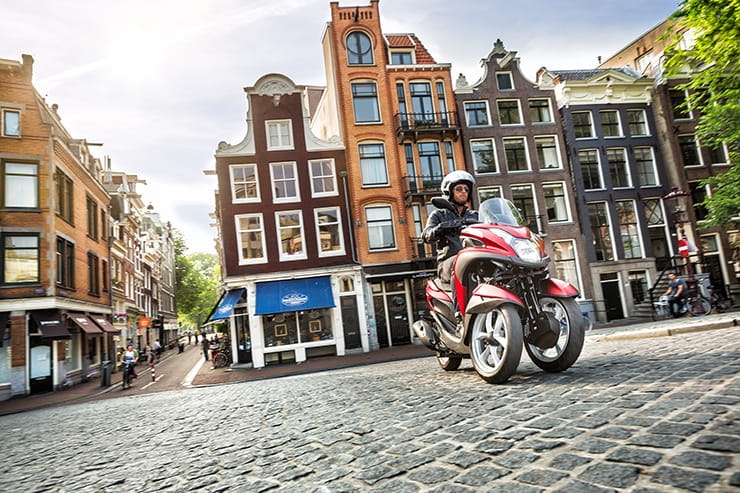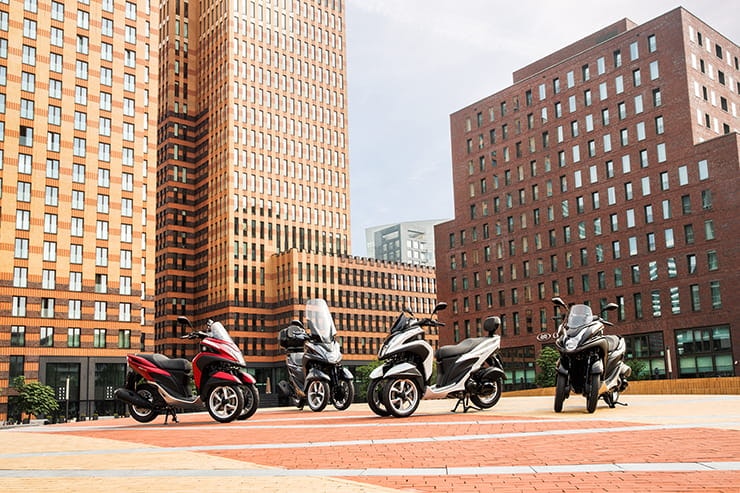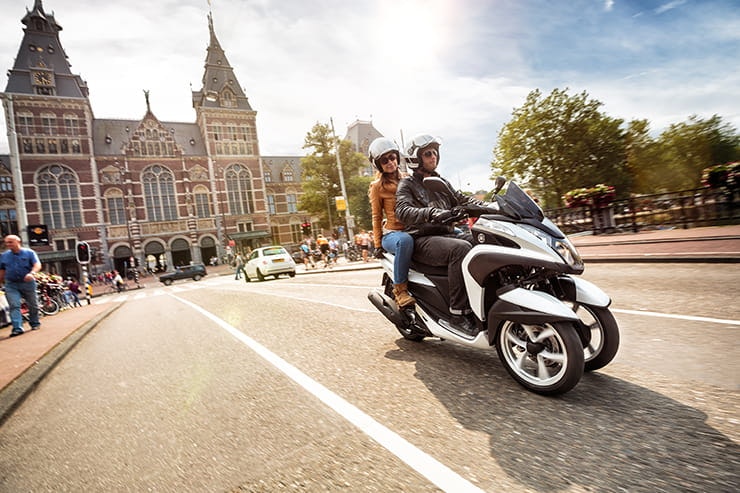Yamaha Tricity 125 (2014 - current) - Review & Buying Guide
By Jon Urry
Massively experienced road tester
04.10.2021
When Yamaha pulled the covers off the Tricity 125 in 2014 who could have predicted that a few years later they would release possibly the maddest bike of recent times – the Niken. But that’s a whole new story, for now let’s just look at what was billed at the time as the first step of Yamaha’s ‘new mobility’ product range. Aimed at getting urban riders onto two (err, three...) wheels, the Tricity’s name says it all. With two front wheels it followed the path set by other three-wheelers such as the Piaggio MP3 and offered a greater level of safety through a doubling up of the front tyre’s contact patch. However, in typical Yamaha fashion, they chose a different path when it came to the actual design of the front end... The rest of the bike is fairly standard 125cc scooter stuff but why rock the boat unnecessarily? If you are a nervous type and are looking for an urban commuter with a bit more of a safety margin built in, the Tricity makes a lot of sense and can be ridden on a provisional A1-licence, which means you just need to pass CBT to hit the highways.
Yamaha Tricity 125 (2014 - current) Price
The Tricity was fairly good value in 2014 with a new price tag of £3399. Nowadays a brand new one will cost you £4150. Although there are a few very high mileage (over 30,000 miles) bikes out there for sale for £1500, you are far better off spending in the region of £2500 for one with around 10,000-miles on its clocks in a private sale or £3000 from a dealer. Used prices are pretty static on the Tricity so the difference between a 2014 model and a 2020 one is only about £500-£1000. Ideally, find a low mileage fairly new (2019 or 2020) used example in a private sale for roughly £3500. There are a few very low mileage bikes out there that have probably been bought and then the owners have decided that commuting isn’t for them. The Tricity was updated in 2017 but in reality, few buyers will care about this as the update (aside from it adding ABS and a bit more tank range) does little to alter its ride, looks or performance.
Power and torque
Powered by Yamaha’s 125cc motor and weighing more than a two-wheeled scooter the Tricity isn’t the fastest 125 on the market but it does enough to get you through an urban commute. In 2017 the 2-valve motor was updated to the Blue Core engine from the NMAX 125 with its 4-valve head with variable valve timing but that doesn’t make a significant difference to power or economy figures. Happy to zip up to an indicated 65mph (given time...) the Tricity is a fairly standard CVT scooter that will beat most cars away from the traffic lights and deliver impressively high economy figures. Two-up it will always struggle due to a lack of grunt but for solo commuting it ticks most boxes.
Engine, gearbox and exhaust
It is hard to say too much about the Tricity’s motor because as with all 125 scooters, it is simply there to fulfil a purpose and as long as it is reliable and economical, that’s all that is required of it. On this score the Tricity is hard to fault and while the 2017-onwards Blue Core engine is technically better than the original motor in reality they do the same job. In terms of servicing, the Tricity requires a service every 2400 miles (4000km) with the spark plug replaced at 4800 mile intervals, the valve clearances checked every 7200-miles and the V-belt changed every 12,000 miles. It is worth checking the more major services have been completed but doing the basic oil change at 2400 miles is pretty simple for a home DIY-er. Expect to pay roughly £300 for a valve-clearance service and the same for the V-belt one. If the bike lacks any service history, factor in £300 to get it looked at by a qualified Yamaha mechanic and expect the valve-clearances to require adjusting. As is common on cheaper 125s, the exhaust is mild steel and likes to rust however a new one only costs about £260 from a known brand so this isn’t a major drama as long as the studs haven’t rusted solid...
Yamaha Tricity 125 (2014 - current) Economy
Small capacity city bikes tend to be very economical and the Tricity is no exception. It may weigh a bit more than a two-wheeled scooter but Yamaha claim 95mpg is achievable and owners seem to agree that this is realistic. As it has a fairly small 7.2-litre tank (6.6 litres on the older pre-2017 model) that equates to roughly 150 miles between fill-ups.
Handling, suspension, chassis and weight
Here is the clever bit and while the 2017-onwards bike does have a 40mm longer wheelbase and a larger 13-inch rear wheel (the older model has a 12-inch item) the handling is basically the same as it is the front end that makes the Tricity unique. Unlike some other three-wheelers the Tricity doesn’t ‘lock’ at slow speed, meaning it will fall over, and that is because it uses a Leaning Multi Wheel (LMW) mechanism with twin forks per side and a parallelogram link to ensure the bike feels as ‘conventional’ as possible due to the wheels leaning. When buying used, there isn’t much you need to worry about aside from the front forks on either side, which actually do the damping, the rear two are just there to act as guides. Always check them for any leaks and also inspect the whole front end for damage – city bikes do hit kerbs/cars and the wheels are lightweight alloy so can ding easily. On the go the Tricity takes a bit of getting used to but once you remember you need to put your foot down when stopping and adjust to the extra weight up front it is very assured and rapidly gives you loads of confidence in iffy conditions. The extra weight isn’t too apparent and thanks to a small track the Tricity can nip through most gaps a conventional two-wheeler will go, you just need to be careful not to catch a front wheel on a kerb as that can throw you a bit off line as the wheel is kicked straight!
Yamaha Tricity 125 (2014 - current) Brakes
There isn’t much to get excited about here as the Tricity has a very basic twin single-piston caliper front set-up with another single piston rear. A Unified system, when the left-hand brake lever (rear) is applied it also activates the front calipers where the right-hand lever applies the front only. Grab both levers and the braking forces are distributed to both ends. It’s basic but provides enough stopping power for a 125 city bike. The 2017-onwards model adds ABS.
Comfort over distance and touring
The 2017 bike does gain a slightly larger storage compartment as well as a 12v socket in its cubbyhole but again, this is minimal advantage. For a city commute the Tricity is perfectly comfortable and although the mirrors are irritatingly poor, that’s about the only gripe. Touring isn’t really an option on a 125 but there are used Tricitys out there with over 30,000 miles on their clocks so they must be pretty good at hacking out the commuting miles.
Rider aids and extra equipment / accessories
There isn’t much in the way of rider assists aside from ABS on the later model but you do get an extra wheel with the Tricity, which is quite an assist in damp conditions. In terms of accessories, a top box is recommended as the underseat storage is pretty limited and then you are down to the usual heated grips, scooter apron, crash protection etc.
Yamaha Tricity 125 (2014 - current) verdict
Unlike the pricey Niken, the Tricity 125 makes total sense. As a commuting tool it brings a bit more security to the party and thanks to Yamaha’s clever design of front end it doesn’t feel unwieldy or cumbersome. Some may not like the fact it can fall over but the plus side of Yamaha’s LMW design is that it rides and feels far more akin to a conventional motorcycle. As a city commuter, the Tricity certainly hits the mark.
Three things we love about the Tricity 125…
Practicality
Extra security from front end
Economy figures
Three things that we don’t…
It is heavier to manoeuvre than a scooter
You need to remember it can fall over!
There is still a bit of a stigma surrounding three wheeled bikes
Yamaha Tricity 125 (2014 - current) spec
Looking for bike insurance? Get a quote for this motorcycle with Bennetts motorbike insurance


